
|
| |
1910–1924 | 1925–1926 | 1927–1930 | 1931–1943 | MORE RECENT
THEATREGOERS OF GOTHAM The Story of Harry Houdini
His trick of vanishing an elephant, which he performed at the Hippodrome for the first time last Monday, he declares to be based upon an entirely new principle, and not merely an enlargement of the familiar “cabinet trick.” The management of the Hippodrome has no idea how the trick is worked; even the stage hands who draw out the cabinet have so far failed to get a clue. With Houdini, however, are four men of his own, men whom he carries with him in season and out, and these men know something, but not everything, of his methods. Not even the keeper who disappears with the elephant, declares Houdini, knows how it is done. The elephant and the keeper are done away with by different methods, both of which are so complicated—still according to Houdini—that the elephant has just as good a chance of understanding it as the keeper.
His ability to do what he wanted with locks Houdini traces back to the age of 5, when the family preserve closet, located in Appleton, Wis., gave way readily before his very touch. Houdini, incidentally, was not his name at the time (he adopted it legally about thirty years ago). His first name was Eric; his second, for certain reasons, may not be here divulged. He was born—in Appleton, as aforesaid—on April 6, 1874. He cannot remember the time when he was not an acrobat and a contortionist. At the age of 7 he observed a traveling showman walk a tight rope in the main street of the town, varying this feat by hanging by his teeth from the cable. Not knowing that a special mouth-fitting contrivance is required for this trick, Houdini tried it in the backyard the same afternoon—and lost five teeth. A year later, at the age of 8, he joined a five-cent circus which was showing in Appleton. At this time he was probably the mental equal of the average youth of 15 or 18. His first name, Eric, fitted a circus career so well that he retained it, calling himself, “Eric, Prince of the Air.” His act, incidentally, he called “The Dead Man’s Drop.” At this time, it must be remembered, he was a contortionist, acrobat, wire walker, and sleight of hand performer, but as yet had not developed any of his other abilities professionally. One of his tricks at this time was a variant of the contortionistic trick of bending backward and picking up an article with his mouth. Houdini went the rest several better by picking up a pin with his eye.
When he began this work he was about 11. In the ring at Coffeyville, Kan., one night, it happened to be a Sheriff who tied him, and as he did so he pulled a pair of handcuffs from his pocket. “If I put these on you you couldn’t get loose,” he remarked. Houdini, remembering his early experiments at home, told him to go ahead and put them on. The Sheriff did so, Houdini freed himself, and his work as a handcuff expert was begun. From 1885 to 1900 he played in museums, music halls, circuses, and medicine shows all over the country, gradually improving his work and slowly discarding his purely contortionistic and acrobatic achievements. During the latter portion of this period he played many times in New York, but never attracted any particular attention. In fact, he never attracted any.
Houdini toured England and the Continent for six years, during which time he escaped from dozens of famous prisons. Cell-breaking, incidentally had been made compulsory with him one day when he lost the key to his hotel room and was unable to open the door. The ridicule which this happening drew down upon him led him to make a thorough study of this form of lock, with the result that he can now open practically any door with but little effort. In 1902, one of his tricks having been doubted by the police of Cologne, he demanded an apology and remained in Cologne an entire year to fight the case in the courts. He felt at the time that his career was ruined unless he obtained the apology, and eventually he got it, “in the name of the Kaiser.” In 1901 he received a challenge from the workingmen of the Krupp plant at Essen and freed himself from specially constructed shackles before 70,000 people. He returned to America in 1905, bringing with him innumerable certificates and sworn statements from authorities all over Europe. He found America—amusement America—a vastly different country from the America that he had left. Vaudeville had been organized and was under a single head, and Houdini, who had previously worked one week out of three and received $30 for it, came into his own at last.
By this time he was sufficiently skilled to do many of his escapes without any concealing device and began to make his straitjacket escape in the open air, hanging head down from the roof of a building. This public display, of course, was designed merely to stimulate interest in his vaudeville appearances. During this period he issued a challenge to all who might think that they could invent devices to hold him, and as a result escaped from a series of plate-glass boxes, riveted iron boilers, paper bags, zinc-lined piano boxes, packing cases, padded cells, straitjackets, insane cribs, willow hampers, iron cages, burglar-proof safes and a United States leather mail pouch. In 1912 he first performed the submarine trick now used at the Hippodrome. Manacled and nailed in a wooden packing case, which was afterward burdened with iron weights and fastened with iron clamps, he was thrown into New York Harbor, just off Sandy Hook. It is more or less needless to add that he escaped.
Since returning to America Houdini has made countless trips abroad, and has given shows and demonstrations in every part of Europe, Asia, and Africa. In 1910, while in Australia, he learned that the grave of John Henry Harrison Davenport, who had died in Australia, was badly kept. He saw to its rehabilitation, and upon his return to this country he was sought out by the surviving Davenport, Ira Erastus, who, in return for the good deed, gave him the secrets of their various rope tricks, some of which were still unknown to Houdini. “We started it,” he told the younger man. “Now you finish it.” This article is reproduced here only for educational purposes. Please do not copy the text or accompanying images for commercial use.
|
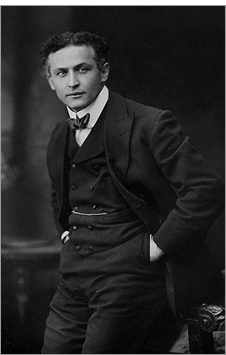 Whatever the trick or tricks by which Harry Houdini has been deceiving the world at large for the last thirty-five years, his career stamps him as one of the greatest showmen of modern times. In his field Houdini stands alone. With a few minor exceptions he has invented one and all of the countless tricks and illusions of which he is master, and he has done his job so well that not even his fellow-conjurors are certain of his methods. There are, of course, certain well-established principles upon which rest the performance of a majority of tricks, but Houdini has invented principles of his own. The result is that he has no imitators. Some of his feats of extrication, of course, are attributable to the fact that he is a contortionist and an acrobat, and these, naturally, can be duplicated by others of equal physical dexterity. His more subtle effects, however, are known only to himself.
Whatever the trick or tricks by which Harry Houdini has been deceiving the world at large for the last thirty-five years, his career stamps him as one of the greatest showmen of modern times. In his field Houdini stands alone. With a few minor exceptions he has invented one and all of the countless tricks and illusions of which he is master, and he has done his job so well that not even his fellow-conjurors are certain of his methods. There are, of course, certain well-established principles upon which rest the performance of a majority of tricks, but Houdini has invented principles of his own. The result is that he has no imitators. Some of his feats of extrication, of course, are attributable to the fact that he is a contortionist and an acrobat, and these, naturally, can be duplicated by others of equal physical dexterity. His more subtle effects, however, are known only to himself.
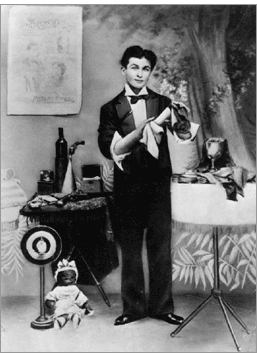 For his second Hippodrome stunt Houdini escapes from a packing box—a box tightly locked and bound—which is thrown into the Hippodrome tank. This is a trick which, owing to space limitations, he never has been able to perform before on a stage, but it is similar in principle to several other of his escapes. All of these things, together with his handcuff work, &c., Houdini attributes to an inborn mechanical genius which began to manifest itself long before he knew what it was. It is this genius which, coupled with his instinct for showmanship, has given him his present undisputed position in the amusement world.
For his second Hippodrome stunt Houdini escapes from a packing box—a box tightly locked and bound—which is thrown into the Hippodrome tank. This is a trick which, owing to space limitations, he never has been able to perform before on a stage, but it is similar in principle to several other of his escapes. All of these things, together with his handcuff work, &c., Houdini attributes to an inborn mechanical genius which began to manifest itself long before he knew what it was. It is this genius which, coupled with his instinct for showmanship, has given him his present undisputed position in the amusement world.
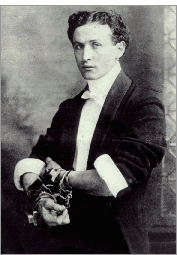 At 9 he joined a traveling circus and toured the State as contortionist and trapeze performer. The world famous Davenport Brothers—Ira Erastus and John Henry Harrison—were then at the height of their fame, doing the first alleged spiritualistic work that the country had seen. One of their specialties was to ring bells inside a cabinet while they were bound hand and foot. They also contracted to effect an escape no matter how tightly they were bound. Houdini, hearing of their work, decided that any one physically deft could do something of the same sort, and he, accordingly, began to do rope escapes. Standing in the centre of the ring, he would invite any one in the audience to bind him, and would then free himself inside a cabinet.
At 9 he joined a traveling circus and toured the State as contortionist and trapeze performer. The world famous Davenport Brothers—Ira Erastus and John Henry Harrison—were then at the height of their fame, doing the first alleged spiritualistic work that the country had seen. One of their specialties was to ring bells inside a cabinet while they were bound hand and foot. They also contracted to effect an escape no matter how tightly they were bound. Houdini, hearing of their work, decided that any one physically deft could do something of the same sort, and he, accordingly, began to do rope escapes. Standing in the centre of the ring, he would invite any one in the audience to bind him, and would then free himself inside a cabinet.
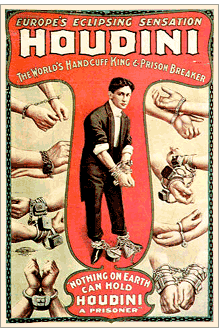 In 1900 he made his first trip abroad, purely on speculation. To interest Dundas Slater, then manager of the Alhambra, he gave a demonstration of escape from handcuffs at Scotland Yard, and succeeded in baffling the police so effectively that he was booked at the Alhambra for six months. It was at about this time that, in accordance with the custom of the times, Houdini began to call himself the Handcuff King, a phrase which afterward became world-famous. Today, in a less gaudy age, it has become a phrase which he is desperately trying to live down.
In 1900 he made his first trip abroad, purely on speculation. To interest Dundas Slater, then manager of the Alhambra, he gave a demonstration of escape from handcuffs at Scotland Yard, and succeeded in baffling the police so effectively that he was booked at the Alhambra for six months. It was at about this time that, in accordance with the custom of the times, Houdini began to call himself the Handcuff King, a phrase which afterward became world-famous. Today, in a less gaudy age, it has become a phrase which he is desperately trying to live down.
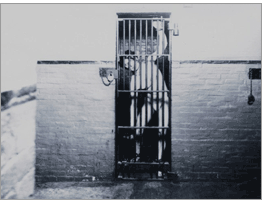 In this country he continued his cell escapes, in January of 1906 breaking out of Cell 2 in the United States Jail at Washington—the cell in which Guiteau had been confined. In 1908 he dropped the handcuff escapes for more dangerous feats, including an escape from an air-tight galvanized vessel, filled with water, which had been locked into an iron-bound chest. He also invented the so-called torture cell, in which he was bound and suspended head downward in a receptacle filled with water. This trick he still does upon occasions.
In this country he continued his cell escapes, in January of 1906 breaking out of Cell 2 in the United States Jail at Washington—the cell in which Guiteau had been confined. In 1908 he dropped the handcuff escapes for more dangerous feats, including an escape from an air-tight galvanized vessel, filled with water, which had been locked into an iron-bound chest. He also invented the so-called torture cell, in which he was bound and suspended head downward in a receptacle filled with water. This trick he still does upon occasions.
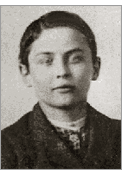 Of his quartet of confidential retainers, one of them has been with him ten years, and two of the others for eight years. Another, a German, had been in his employ fourteen years, and a parting was then necessitated by this country’s entrance into the war. All of his helpers are men whom he has picked up in machine shops and trained to suit his needs.
Of his quartet of confidential retainers, one of them has been with him ten years, and two of the others for eight years. Another, a German, had been in his employ fourteen years, and a parting was then necessitated by this country’s entrance into the war. All of his helpers are men whom he has picked up in machine shops and trained to suit his needs.